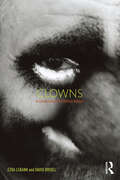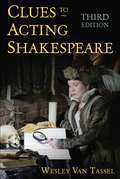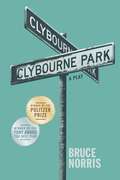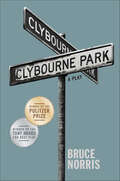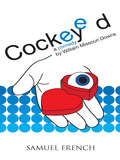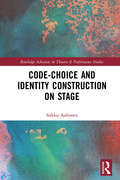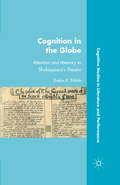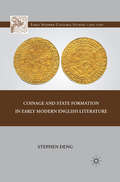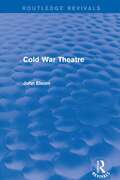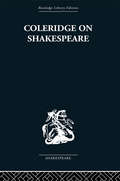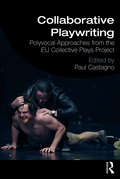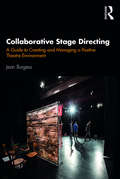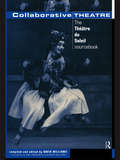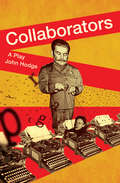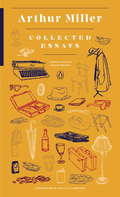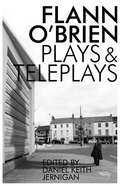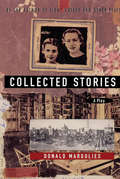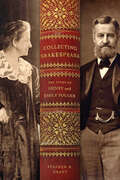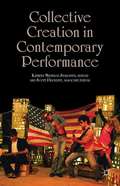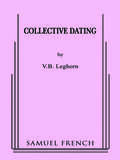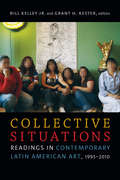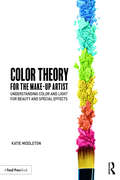- Table View
- List View
Clowning and Authorship in Early Modern Theatre
by Richard PreissTo early modern audiences, the 'clown' was much more than a minor play character. A celebrity performer, he was a one-man sideshow whose interactive entertainments - face-pulling, farce interludes, jigs, rhyming contests with the crowd - were the main event. Clowning epitomized a theatre that was heterogeneous, improvised, participatory, and irreducible to dramatic texts. How, then, did those texts emerge? Why did playgoers buy books that deleted not only the clown, but them as well? Challenging the narrative that clowns were 'banished' by playwrights like Shakespeare and Jonson, Richard Preiss argues that clowns such as Richard Tarlton, Will Kemp, and Robert Armin actually made playwrights possible - bridging, through the publication of their routines, the experience of 'live' and scripted performance. Clowning and Authorship tells the story of how, as the clown's presence decayed into print, he bequeathed the new categories around which theatre would organize: the author, and the actor.
Clowns: In conversation with modern masters
by Ezra LeBank David BridelClowns: In Conversation with Modern Masters is a groundbreaking collection of conversations with 20 of the greatest clowns on earth. In discussion with clown aficionados Ezra LeBank and David Bridel, these legends of comedy reveal the origins, inspirations, techniques, and philosophies that underpin their remarkable odysseys. Featuring incomparable artists, including Slava Polunin, Bill Irwin, David Shiner, Oleg Popov, Dimitri, Nola Rae, and many more, Clowns is a unique and definitive study on the art of clowning. In Clowns, these 20 master artists speak candidly about their first encounters with clowning and circus, the crucial decisions that carved out the foundations of their style, and the role of teachers and mentors who shaped their development. Follow the twists and turns that changed the direction of their art and careers, explore the role of failure and originality in their lives and performances, and examine the development and evolution of the signature routines that became each clown’s trademark. The discussions culminate in meditations on the role of clowning in the modern world, as these great practitioners share their perspectives on the mysterious, elusive art of the clown.
Clues to Acting Shakespeare
by Wesley Van TasselClues to Acting Shakespeare has become a popular guide for actors, directors, teachers and Shakespeare enthusiasts, selling over 15,000 copies of previous editions. This third edition retains the second edition’s unique solutions to challenges that face directors and actors at advanced levels and is expanded to include an entirely new section for amateur and community theatre groups. In this new edition, readers will be delighted to find: New section to aid community theatres to perform Shakespeare’s plays, including five recorded workshops of community theatre actors coached and trained by the author Updates to the successful sections on training student actors (MFA and BFA programs), and professional actors (including audition tips)—highlighted by twenty author-coached workshops with professional and advanced student actors Improved section for teachers of high school and child actors with worksheets and sample lesson plans New exercises and resources for all levels of acting and production To aid professionals, Clues to Acting Shakespeare offers a one-day brush-up for auditions and preparation to play Shakespeare immediately. Text analysis, character studies, and both classical British training and American methods are explored. The exercises and recorded workshops provide inspiring advice to all actors and demonstrate concepts discussed throughout the book. The critical skills required for acting Shakespeare, including scansion, phrasing, caesura, breathing, speech structure, antithesis, and more are covered in detail. The comprehensive exercises using the Bard’s plays and sonnets teach actors to break down the verse, support the words, understand the imagery, and use the text to create vibrant performances.
Clybourne Park: A Play
by Bruce NorrisClybourne Park spans two generations fifty years apart. In 1959, Russ and Bev are selling their desirable two-bedroom at a bargain price, unknowingly bringing the first black family into the neighborhood (borrowing a plot line from Lorraine Hansberry's A Raisin in the Sun) and creating ripples of discontent among the cozy white residents of Clybourne Park. In 2009, the same property is being bought by a young white couple, whose plan to raze the house and start again is met with equal disapproval by the black residents of the soon-to-be-gentrified area. Are the issues festering beneath the floorboards actually the same, fifty years on? Bruce Norris's excruciatingly funny and squirm-inducing satire explores the fault line between race and property. Clybourne Park is the winner of the 2011 Pulitzer Prize for Drama, and the winner of the 2012 Tony Award for Best Play.
Clybourne Park: A Play
by Bruce NorrisA Chicago house becomes a contested site in the politics of race in this “superb, elegantly written, and hilarious” play (The New Yorker).Winner, Pulitzer Prize for DramaWinner, Tony Award for Best PlayClybourne Park spans two generations fifty years apart. In 1959, Russ and Bev are selling their desirable two-bedroom at a bargain price, unknowingly bringing the first black family into the neighborhood (borrowing a plot line from Lorraine Hansberry's A Raisin in the Sun) and creating ripples of discontent among the cozy white residents of Clybourne Park. In 2009, the same property is being bought by a young white couple, whose plan to raze the house and start again is met with equal disapproval by the black residents of the soon-to-be-gentrified area. Are the issues festering beneath the floorboards actually the same, fifty years on? Bruce Norris's excruciatingly funny and squirm-inducing satire explores the fault line between race and property.“A spiky and damningly insightful new comedy.” —The New York Times“Indisputably, uproariously funny, and a quietly evocative meditation on the by-no-means-obsolete stereotypes that pervade millennial melting-pot America.” —Entertainment Weekly“Courageous. . . . Norris’s elegantly structured play nails marital tensions as much as it does racial disharmony in an evening of ebullient provocation.” —The Guardian
Cockeyed
by William Missouri DownsComedy / Character: 3m, 1w / Unit Set Phil, an average nice guy, is madly in love with the beautiful Sophia. The only problem is that she's unaware of his existence. He tries to introduce himself but she looks right through him. When Phil discovers Sophia has a glass eye, he thinks that might be the problem, but soon realizes that she really can't see him. Perhaps he is caught in a philosophical hyperspace or dualistic reality or perhaps beautiful women are just unaware of nice guys. Armed only with a B.A. in philosophy, Phil sets out to prove his existence and win Sophia's heart. This fast moving farce is the winner of the HotCity Theatre's GreenHouse New Play Festival. The St. Louis Post-Dispatch called Cockeyed a clever romantic comedy, Talkin' Broadway called it "hilarious," while Playback Magazine said that it was "fresh and invigorating." Winner of the HotCity Theatre GreenHouse New Play Festival "Rocking with laughter...hilarious...polished and engaging work draws heavily on the age-old conventions of farce: improbable situations, exaggerated characters, amazing coincidences, absurd misunderstandings, people hiding in closets and barely missing each other as they run in and out of doors...full of comic momentum as Cockeyed hurtles toward its conclusion." - Talkin' Broadway
Code Kakori: कोड काकोरी
by Manoj Rajan Tripathiइस कहानी का बीज मेरे सामने बोया गया था और आज कहानी फसल बन कर लहलहा रही है, CODE काकोरी को दिल से मुबारकबाद - साजिद नाडियाडवाला। काकोरी अस्पताल के वॉर्ड में एक डेड बॉडी पड़ी है, जो पूरी तरह काली पड़ चुकी है। लाश पर सोने-चांदी के ब्रिटिश कॉइंस पड़े हैं। हर सिक्के पर क्वीन विक्टोरिया की तस्वीर छपी है। क़ातिल ने लाश के सीने पर पीतल की थंब पिन से एक ए फोर साइज़ का कागज़ टैग किया है, जिस पर लिखा है—हिंदुस्तान रिपब्लिकन एसोसिएशन। आख़िर क़ातिल का इशारा क्या है? क्यों छोड़े हैं उसने ये सुराग़? पुलिस को क्यों चैलेंज कर रहा है ये क़ातिल? असल में ये वही विक्टोरियन कॉइंस हैं, जो 1925 के ‘काकोरी कांड’ में लूटे गए थे। ये वही हिंदुस्तान रिपब्लिकन एसोसिएशन है जो 1924 में चंद्रशेखर आज़ाद ने बनाई थी। तब मक़सद था ब्रिटिश हुकूमत के ख़िलाफ़ बारूदी जंग छेड़ना, और बारूद उगलने वाले हथियार ख़रीदने के लिये 9 अगस्त 1925 को ट्रेन रोककर काकोरी में ही लूटा गया, अंग्रेज़ों का खज़ाना। लेकिन चौरानवे साल बाद अब क्या मक़सद है? अब क्या इरादा है? किसके ख़िलाफ़ है ये जंग? अब कौन है जिसने बनाया है ‘कोड काकोरी’? मनोज राजन त्रिपाठी के इस उपन्यास में थ्रिल है, सस्पेंस है, एक्शन है, कॉमेडी है, ड्रामा है; कहने का मतलब, एक पूरी फ़िल्म का मज़ा है।
Code-Choice and Identity Construction on Stage: Code-choice in Identity Construction on Stage (Routledge Advances in Theatre & Performance Studies)
by Sirkku AaltonenCode-Choice and Identity Construction on Stage challenges the general assumption that language is only one of the codes employed in a theatrical performance; Sirkku Aaltonen changes the perspective to the audience, foregrounding the chosen language variety as a trigger for their reactions. Theatre is ‘the most public of arts’, closely interwoven with contemporary society, and language is a crucial tool for establishing order. In this book, Aaltonen explores the ways in which chosen languages on stage can lead to rejection or tolerance in diglossic situations, where one language is considered unequal to another. Through a selection of carefully chosen case studies, the socio-political rather than artistic motivation behind code-choice emerges. By identifying common features of these contexts and the implications of theatre in the wider world, this book sheds light on high versus low culture, the role of translation, and the significance of traditional and emerging theatrical conventions. This intriguing study encompassing Ireland, Scotland, Quebec, Finland and Egypt, cleverly employs the perspective of familiarising the foreign and is invaluable reading for those interested in theatre and performance, translation, and the connection between language and society.
Cognition in the Globe: Attention and Memory in Shakespeare’s Theatre (Cognitive Studies in Literature and Performance)
by Evelyn B. TribbleEarly modern playing companies performed up to six different plays a week and mounted new plays frequently. This book seeks to answer a seemingly simple question: how did they do it? Drawing upon work in philosophy and the cognitive sciences, it proposes that the cognitive work of theatre is distributed across body, brain, and world.
Coinage and State Formation in Early Modern English Literature (Early Modern Cultural Studies 1500–1700)
by Stephen DengA reassessment of the historic relation between money and the state through the lens of early modern English literature, Coinage and State Formation examines the political implications of the monetary form in light of material and visual properties of coins as well as the persistence of both intrinsic and extrinsic theories of value.
Cold War Theatre (Routledge Revivals)
by John ElsomCold War Theatre, first published in 1992, provides an account of the theatrical history within the context of East/West politics. Its geographical span ranges from beyond the Urals to the Pacific Coast of the US, and asks whether the Cold War confrontation was not in part due to the cultural climate of Europe. Taking the McCarthy era as its starting point, this readable history considers the impact of the Cold War upon the major dramatic movements of our time, East and West. The author poses the question as to whether European habits of mind, fostered by their cultures, may not have contributed to the political stalemates of the Cold War. A wide range of actors from both the theatrical and political stages are discussed, and their contributions to the theatre of the Cold War examined in a hugely enjoyable and enlightening narrative. This book is ideal for theatre studies students.
Coleridge on Shakespeare: The text of the lectures of 1811-12 (Monographs)
by R. A. FoakesFirst published in 1971. The only substantial text of a series of lectures on Shakespeare by S T Coleridge is that provided by J P Collier's Seven Lectures on Shakespeare and Milton (1856). His text of these important lectures given by Coleridge in 1811-12 has been the basis of all modern editions. This edition is based on hitherto unpublished transcripts of the lectures made by Collier when, as a young man, he attended Coleridge's lectures. R A Foakes' introduction and appendices demonstrate the extent to which Collier revised and altered Coleridge's words for the edition he published forty-five years later. This volume therefore provides a much more authoritative text of Coleridge's most important Shakespeare lectures.
Collaborative Playwriting: Polyvocal Approaches from the EU Collective Plays Project
by Paul CastagnoIn Collaborative Playwriting, five collectively written plays apply polyvocal methods in which clash and frisson replace synthesis, a dialogic approach to collective writing that has never before been articulated or documented. Based on the EU Collective Plays Project, this collection of plays showcases each voice in dialogic tension and in relation to the other voices of the text, offering an entirely novel approach to new play development that challenges the single (and privileged) authorial voice. Castagno’s case-study approach provides detailed commentary on each of the various experimental methods, exploring the plays’ processes in detail. The book offers an evolutionary path forward in how to develop new work, thus encouraging and promoting the writing of collective, hybrid plays as having profound benefits for all playwrights. The ground breaking approaches to playmaking in Collaborative Playwriting will appeal to playwriting programs, instructors, academics, professional playwrights, theaters and new play development programs; as well as courses in gender LGBTQ studies, script analysis, dramaturgy and dramatic literature across the theater studies curricula.
Collaborative Stage Directing: A Guide to Creating and Managing a Positive Theatre Environment
by Jean BurgessCollaborative Stage Directing: A Guide to Creating and Managing a Positive Theatre Environment focuses on the director’s collaboration with actors and the creative team, and the importance of communication and leadership skills to create and manage a healthy working environment. Speaking directly to the student, this compact resource walks the aspiring director through basic principles of group dynamics, active listening, open-ended questioning, brainstorming, and motivational leadership, supported by examples and case studies offered by current professional and academic directors. With a focus on preparing the student director for resume-building opportunities beyond the studio lab, Collaborative Stage Directing challenges readers with reflective activities, a series of guiding questions to apply to three short plays, and an extensive checklist to assist them with independent directing projects. As an easy-to-use resource, Collaborative Stage Directing works as a supplement to a classic directing text or as a stand-alone guide.
Collaborative Theatre: Le Theatre du Soleil
by David Williams Eric PrenowitzOver the past thirty years Ariane Mnouchkine's 'Théâtre du Soleil' has become one of the most celebrated companies in Europe, and Mnouchkine one of its best-known directors. Collaborative Theatre is the first in-depth sourcebook in English on 'Théâtre du Soleil', providing English readers with first-hand accounts of the development of its collectivist practices and ideals.Collaborative Theatre presents critical and historical essays by theatre scholars from around the world as well as the writings of and interviews with members of le Théâtre du Soleil, past and present. Projects discussed include: 1789, L'Age d'Or, Richard II, L'Indiade and Les Atriades.
Collaborators: A Play (Books That Changed the World)
by John HodgeThis “gripping, disturbing, and often blackly comic drama” explores the historic connection between Stalin and Russian author Mikhail Bulgakov (The Daily Telegraph, UK).A “rare and special” play by the screenwriter of Trainspotting and Shallow Grave, Collaborators is inspired by the true story of another play: one that Mikhail Bulgakov was forced to write in commemoration Joseph Stalin’s sixtieth birthday (The Times, UK).Moscow, 1938. Stalin has been in power for sixteen years and his purges are underway. Bulgakov’s The Master and Margarita is lying unpublished in a desk drawer, and his latest play Molière has been banned following terrible reviews in Pravda. As a secret policeman dryly puts it, this has opened up a convenient “gap in his schedule.” This “gap” is to be filled by writing a play about Stalin’s life.As Bulgakov loses himself in a world of secrets, threats, and paradoxes, he begins to fall ill from kidney disease. His feverish dreams of conversations with Stalin become reality in his mind, just as the state’s lies become truths in his play. Collaborators is a darkly comic portrait of the impossible choices facing an artist living under dictatorship, and a surreal journey into the imagination of a writer as he loses himself in the subject of his drama.Winner of the 2012 Laurence Olivier Awards Best New Play
Collected Essays (Penguin Classics)
by Arthur Miller Susan C. AbbotsonThe collected essays of the "moral voice of [the] American stage" (The New York Times) in a Penguin Classics Deluxe Edition Arthur Miller was not only one of America's most important twentieth-century playwrights, but he was also one of its most influential literary, cultural, and intellectual voices. Throughout his career, he consistently remained one of the country's leading public intellectuals, advocating tirelessly for social justice, global democracy, and the arts. Theater scholar Susan C. W. Abbotson introduces this volume as a selection of Miller's finest essays, organized in three thematic parts: essays on the theater, essays on specific plays like Death of a Salesman and The Crucible, and sociopolitical essays on topics spanning from the Depression to the twenty-first century. Written with playful wit, clear-eyed intellect, and above all, human dignity, these essays offer unmatched insight into the work of Arthur Miller and the turbulent times through which he guided his country. For more than seventy years, Penguin has been the leading publisher of classic literature in the English-speaking world. With more than 1,700 titles, Penguin Classics represents a global bookshelf of the best works throughout history and across genres and disciplines. Readers trust the series to provide authoritative texts enhanced by introductions and notes by distinguished scholars and contemporary authors, as well as up-to-date translations by award-winning translators.From the Trade Paperback edition.
Collected Plays and Teleplays
by Flann O'Brien Daniel Keith JerniganIn the same spirit as his novels, O'Brien's plays are speculative, inventive, wickedly funny, and a delightful addition to his collected works--now available at last: this volume collects Flann O'Brien's dramatic work into a single volume, including Thirst, Faustus Kelly, and The Insect Play: A Rhapsody on Saint Stephen's Green. It also includes several plays and teleplays that have never before seen print, including The Dead Spit of Kelly (of which a film version is in production by Michael Garland), The Boy from Ballytearim, and An Scian (only recently discovered), as well as teleplays from the RTÉ series O'Dea's Your Man and Th'oul Lad of Kilsalaher.
Collected Plays and Teleplays
by Flann O'Brien Daniel Keith JerniganIn the same spirit as his novels, O'Brien's plays are speculative, inventive, wickedly funny, and a delightful addition to his collected works--now available at last: this volume collects Flann O'Brien's dramatic work into a single volume, including Thirst, Faustus Kelly, and The Insect Play: A Rhapsody on Saint Stephen's Green. It also includes several plays and teleplays that have never before seen print, including The Dead Spit of Kelly (of which a film version is in production by Michael Garland), The Boy from Ballytearim, and An Scian (only recently discovered), as well as teleplays from the RTÉ series O'Dea's Your Man and Th'oul Lad of Kilsalaher.
Collected Stories
by Donald MarguliesIn Collected Stories, playwright Donald Margulies explores the vexed emotional and legal question of a writer's right to create art from the biographical material of another person's life--particularly when that other person is also a writer. Meditating upon the recent, real-life conflict between poet Stephen Spender and novelist David Leavitt, Margulies has created two of the most vivid and moving fictional characters of his career: Ruth Steiner, an aging, highly regarded author who never wrote about her youthful affair with real-life poet Delmore Schwartz, and Debra Messing, a student of Steiner's who, after publishing a much-praised first short-story collection under Steiner's direction, follows up with a novel that draws upon the Schwartz affair.
Collecting Shakespeare: The Story of Henry and Emily Folger
by Stephen H. GrantThe first biography of Henry and Emily Folger, who acquired the largest and finest collection of Shakespeare in the world.In Collecting Shakespeare, Stephen H. Grant recounts the American success story of Henry and Emily Folger of Brooklyn, a couple who were devoted to each other, in love with Shakespeare, and bitten by the collecting bug.Shortly after marrying in 1885, the Folgers started buying, cataloging, and storing all manner of items about Shakespeare and his era. Emily earned a master's degree in Shakespeare studies. The frugal couple worked passionately as a tight-knit team during the Gilded Age, financing their hobby with the fortune Henry earned as president of Standard Oil Company of New York, where he was a trusted associate of John D. Rockefeller Sr.While a number of American universities offered to house the collection, the Folgers wanted to give it to the American people. Afraid the price of antiquarian books would soar if their names were revealed, they secretly acquired prime real estate on Capitol Hill near the Library of Congress. They commissioned the design and construction of an elegant building with a reading room, public exhibition hall, and the Elizabethan Theatre. The Folger Shakespeare Library was dedicated on the Bard's birthday, April 23, 1932.The library houses 82 First Folios, 275,000 books, and 60,000 manuscripts. It welcomes more than 100,000 visitors a year and provides professors, scholars, graduate students, and researchers from around the world with access to the collections. It is also a vibrant center in Washington, D.C., for cultural programs, including theater, concerts, lectures, and poetry readings.The library provided Grant with unprecedented access to the primary sources within the Folger vault. He draws on interviews with surviving Folger relatives and visits to 35 related archives in the United States and in Britain to create a portrait of the remarkable couple who ensured that Shakespeare would have a beautiful home in America.
Collective Creation in Contemporary Performance
by Kathryn SyssoyevaThis edited volume situates its contemporary practice in the tradition which emerged at the beginning of the twentieth century. Collective Creation in Contemporary Performance examines collective and devised theatre practices internationally and demonstrates the prevalence, breadth, and significance of modern collective creation.
Collective Dating
by Vb LeghornCOLLECTIVE DATING is a wacky collection of romantic comedies based on the world of dating. From cavemen to the Internet, from an uptight, upright dating service to one that knows no bounds, COLLECTIVE DATING is a wild ride of fun. The plays were written with ease of production in mind. They can be performed in any combination in one evening with a cast of four men and three women or with full casts for each play, allowing for large group performances such as schools or classrooms. Most of the plays are family friendly, and require minimal sets and costumes. Each play runs an average of 20 minutes allowing for five plays to be presented in an evening with a running time of approximately 115 minutes with intermission.
Collective Situations: Readings in Contemporary Latin American Art, 19952010
by Grant H. Kester Bill Kelley Jr. Jr.In Collective Situations scholars, artists, and art collectives present a range of socially engaged art practices that emerged in Latin America during the Pink Tide period, between 1995 and 2010. This volume's essays, interviews, and artist's statements—many of which are appearing in English for the first time—demonstrate the complex relationship between moments of political transformation and artistic production. Whether addressing human rights in Colombia, the politics of urban spaces in Brazil, the violent legacy of military dictatorships in the region, or art’s intersection with public policy, health, and the environment, the contributors outline the region’s long-standing tradition of challenging ideas about art and the social sphere through experimentation. Introducing English-language readers to some of the most dynamic and innovative contemporary art in Latin America, Collective Situations documents new possibilities for artistic practice, collaboration, and creativity in ways that have the capacity to foster vibrant forms of democratic citizenship. Contributors Gavin Adams, Mariola V. Alvarez, Gustavo Buntinx, María Fernanda Cartagena, David Gutiérrez Castañeda, Fabian Cereijido, Paloma Checa-Gismero, Kency Cornejo, Raquel de Anda, Bill Kelley Jr., Grant H. Kester, Suzanne Lacy, Ana Longoni, Rodrigo Martí, Elize Mazadiego, Annie Mendoza, Alberto Muenala, Prerana Reddy, Maria Reyes Franco, Pilar Riaño-Alcalá, Juan Carlos Rodríguez
Color Theory for the Makeup Artist: Understanding Color and Light for Beauty and Special Effects
by Katie MiddletonColor Theory for the Make-up Artist: Understanding Color and Light for Beauty and Special Effects analyzes and explains traditional color theory for fine artists and applies it to the make-up artist. This book is suitable for both professionals and beginners who wish to train their eye further to understand and recognize distinctions in color. It explains why we see color, how to categorize and identify color, relationships between colors, and it relates these concepts to beauty and special effects make-up. The book teaches the reader how to mix flesh tones by using only primary colors, and explains how these colors in paints and make-up are sourced and created. It also discusses the reason for variations in skin colors and undertones, and how to identify and match these using make-up, while choosing flattering colors for the eyes, lips, and cheeks. Colors found inside the body are explained for special effects make-up, like why we bruise, bleed, or appear sick. Ideas and techniques are also described for painting prosthetics, in addition to using color as inspiration in make-up designs. The book also discusses how lighting affects color on film, television, theater, and photography sets, and how to properly light a workspace for successful applications.

